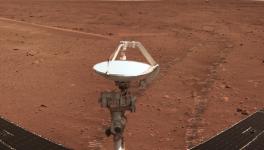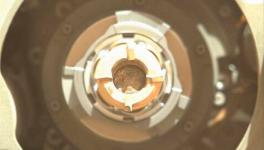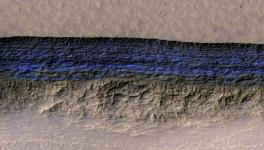What We Thought is Liquid Water on the Surface of Mars is Probably not Liquid Water at All
In 2011, the Mars Reconnaissance Orbiter (MRO) took pictures of several streaks along steep slopes on the surface of Mars. These streaks, named recurring slope lineae (RSL), were observed to grow longer and turn darker as the season changed from spring to summer. It was believed that briny, flowing water is the cause of these streaks.

Alfred McEven, a planetary geologist and the principal investigator for the high-resolution camera on MRO, published a study this month which says the cause of those streaks is more likely to be movement of sand, than liquid water.
McEven analysed 151 streaks with his colleagues and came to the conclusion that the streaks are caused because of the flow of sand and dust.
McEven said in an interview to Science that the team was always doubtful about RSL being caused by liquid water. There may be liquid water in the crust of Mars, but it is unlikely it will come out to the surface on top of the slopes where the streaks were observed. The atmosphere of Mars is much too dry to permit water to concentrate on top of ridges and isolated peaks.
However, there is evidence that those streaks contain hydrated salts, which points to the involvement of water. McEven says that even if there is water present, it does not necessarily mean it is liquid water. One possible reason could be that water-absorbing salts from the atmosphere are being trapped in a thin layer beneath the surface, and this layer is destabilising sand grains, causing them to slip down. Once these sand grains slip, the layer of soil dampened by the atmospheric salts is exposed, giving it a dark appearance. So the cause is possibly not liquid groundwater, but atmospheric water-absorbing salts.
Overall, McEwen said, the exact cause underlying RSL remains mysterious. The possibility of thin films of water somewhere on Mars definitely exists, even if they are not causing the streaks. For microbial life to be present on this surface water, if found, is still an open question, as it will be too salty for life as we know it.
The surface, McEwen says, is a “very harsh environment for life.” But it is quite likely that pockets of liquid water exist underneath the surface of Mars, which can possibly host life.
Europa and Enceladus, the moons of Jupiter and Saturn where oceans of water are present beneath their frozen surfaces, do seem to offer more promising signs of life than Mars. But they are further away from the sun, with Europa being in a harsh radiation environment. Thus, McEven concludes, it is too soon to restrict the search for life to a particular planet or moon. All possibilities need to be explored.
Get the latest reports & analysis with people's perspective on Protests, movements & deep analytical videos, discussions of the current affairs in your Telegram app. Subscribe to NewsClick's Telegram channel & get Real-Time updates on stories, as they get published on our website.
























